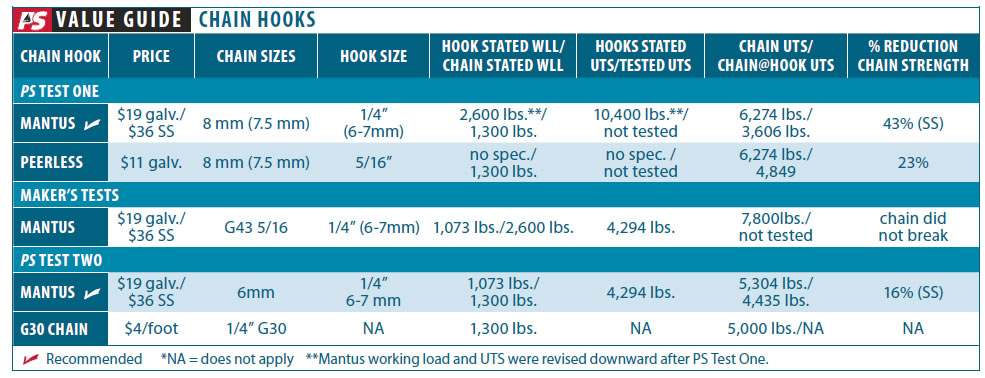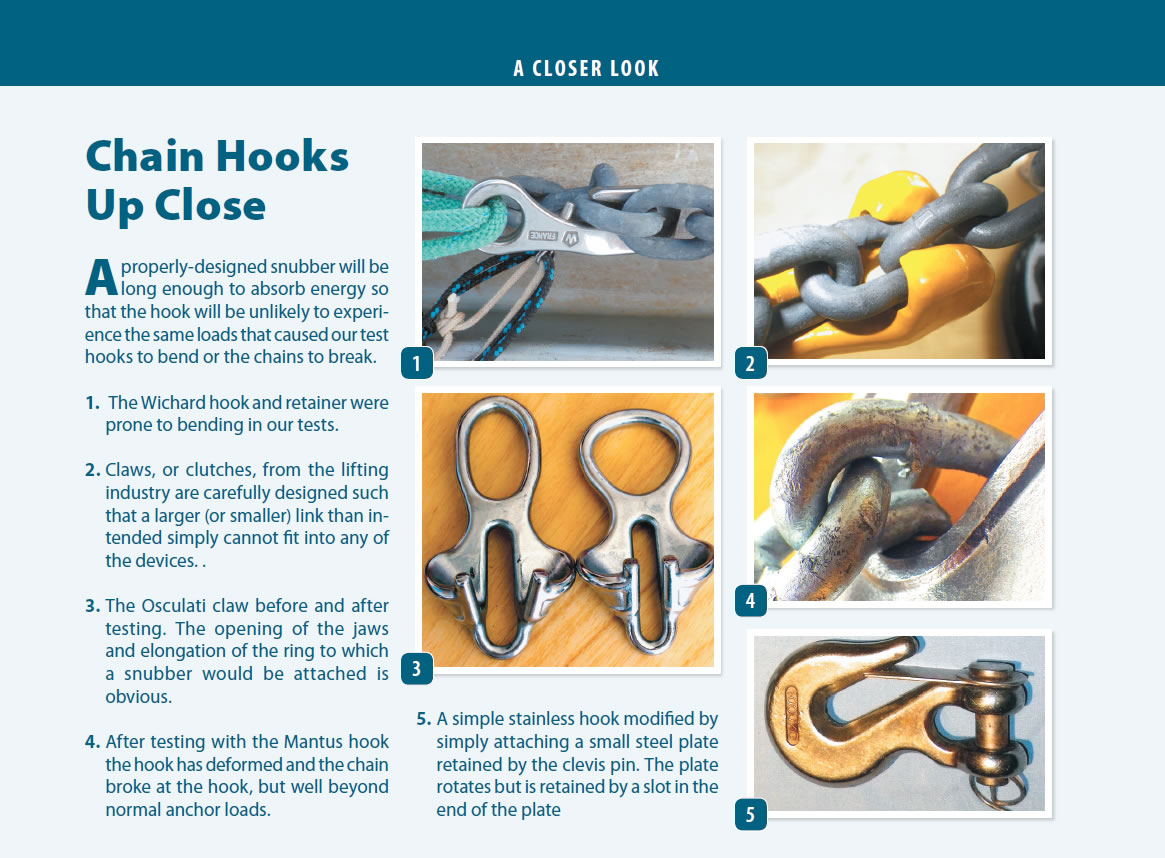Last spring we reported on tests of chain hooks (see Testing the Effects of Chain Hooks, PS March 2016). Those tests found that some hooks reduced the strength and seriously damaged the retained chain. The maker of one of the hooks, Mantus, criticized our methods because the chain size we used did not match their specs for the hook, so we repeated the tests using different chain. (For a complete discussion of this matter, see the Inside PS blog post Can a Snubber Hook Weaken Your Chain?) We also looked at newer products that had been introduced in the interim.
Background
The lifting industry has long recognized that hooks like chandleries sell can reduce chain strength by as much as 25 percent and that the published load limit should be reduced accordingly. Recognizing the issue, the lifting industry has introduced hooks that do not reduce chain strength. Called cradle hooks (aka saddle hooks), claws, or clutch hooks, these designs are widely available and inexpensive-but not in galvanized or stainless-steel versions suitable for the marine environment.
The National Association of Chain Manufacturers (www.nacm.info) specifies load limits for chain. Grade 30 proof-coil chain (G30) sized at 1/4-inch has a working load limit (WLL) of 1,300 pounds and a minimum breaking strength (MBS) of 5,200 pounds. G30 chain at 5/16-inch has a WLL of 1,900 pounds and MBS of 7,600 pounds. In each case, this represents a 4:1 safety factor. G43 high-test chain is rated with a 3:1 safety factor. Many shackles are rated with 6:1 safety factor. Marine chain hooks do not have an established safety factor-another item that prompted our study.
All of our tests were conducted at Robertsons Lifting and Rigging, near Newcastle, Australia, using a Wirop 100 horizontal test bed.
What We Tested: Round One
Our main question was what happens to the chain under load when using the hook? Because we intended to mimic a real-world scenario, we used old chain: in this case, 5/16-inch chain that had degraded significantly. Chain from the same batch had previously been tested and broken; its ultimate tensile strength (UTS) was demonstrated at 6,274 pounds-between the NACM-rated MBS for 1/4-inch G30 chain (5,200 pounds) and 5/16-inch G30 chain (7,600 pounds).
Mantus Chain Hook
In the first test, we mistakenly used a 1/4-inch Mantus Chain Hook, which had a published WLL of 2,600 pounds and MBS of 10,400 pounds. The hook fit the chain and Mantus specs (at that time) indicated it was strong enough for our chain. Like many marine chain hooks, this hook has a relatively finer edges where it meets the chain. In our test, the chain failed at the hook at 3,606 pounds and the Mantus Chain Hook was severely distorted. As Mantus pointed out, we should have followed the makers size recommendation.
Peerless hook
We also tested a 5/16-inch Peerless hook, rated at G30 quality. Its manufacturer had issued a 20-percent strength-reduction warning. The chain tested with the Peerless hook failed at 4,849 pounds-a 23-percent reduction in strength, nearly consistent with the companys strength-reduction warning. The Peerless hook was undamaged.

Aftermath
After we published our findings, Mantus took us to task for our mistake and we promised the following retest. But the test also prompted Mantus to re-evaluate the test protocol it relied on to determine the 1/4-inch hooks load specifications.
After our test, Mantus immediately retested the hook roughly following the PS methodology. For their test, they used 1/4-inch G43 high-test chain (WLL of 2,600 pounds; MBS of 7,800 pounds). As a result of these tests, Mantus reduced their published load rating (For Mantus explanation for the change see: https://goo.gl/kJn8z7). The companys new WLL for the 1/4-inch hook was reduced to 1,073 pounds. We commend Mantus for changing its published load specifications.
We arent surprised that the hook didnt damage G43 chain since its yield point (point of permanent deformation) is much higher than that of G30 chain.

What We Tested: Round Two
We retested a new hook we purchased from the Australian distributor of Mantus products. We used exactly the same protocol but this time used a new PWB 6-millimeter Grade L chain (roughly equivalent to 1/4-inch G30) supplied by Robertsons. When we tested that chain with non-damaging hooks, this chain failed at 5,304 pounds; recall that 1/4-inch G30 has an MBS rating of 5,200 pounds.
Mantus Chain Hook
When we conducted our second test of the Mantus Chain Hook, the chain failed at 4,435 pounds. This represents a 16-percent reduction in strength, consistent with warning from the lifting industry of a 20-percent reduction.
The 16-percent reduction in strength is much lower than the 42-percent reduction we found with our first test with the wrong size hook. Clearly a properly-sized hook makes a difference.
It is worth noting that in both tests, however, the hook clearly caused the chain to fail below its tested strength. Only the link secured by the hook showed signs of damage.
When used with an appropriately sized snubber with adequate elasticity, the Mantus hook should not damage the chain (see What is the Ideal Snubber Size? PS March 2016).
Bottom line: The Mantus chain hook is available in stainless steel and galvanized. Its most helpful feature is the latch which keeps it in place even in tough conditions. It is Recommended for those who insist on a stainless-steel snubber hook, or who don’t want to modify existing lifting hooks.
Osculati hook
This a cast 316-grade stainless-steel claw. We tested 6 to 8-millimeter version (15/64 inch to 5/16 inch). We conducted this test in nearly the same manner as for the Mantus hook. This time, though, we were interested in ultimate strength and we paired the hook with an 8 mm (5/16 inch) G80 alloy chain; the NACM shows its WLL at 4,500 pounds and its MBS at 18,000 pounds.
The Osculati hook failed at 6,527 pounds. Failure occurred when the claw jaws opened and the chain slipped out. We also observed an elongation of the hole to which a snubber would be attached. We would suspect that failure would have occurred at lower loads had we used a 1/4-inch chain, as less tension would be needed to allow the claw jaw to deform and the chain to slip. On the chain we saw no mark of stress on the retained link-consistent with our expectations for robust G80 alloy chain.
Bottom line: The Osculati hook should withstand the loads normally encountered by a properly sized snubber. However, in our view, there are designs that will stay on the chain much more securely.
Conclusion
The Osculati hook, exhibiting no positive reinforcement for retention, simply makes it too easy for the chain to fall free. By contrast, the Mantus hook has a plastic gate, a safety lock that stops the chain falling out. This works well with the small hook. On the larger hook it is stiff and harder to manage.
Mantus reps assert that if the hook is match correctly to chain size and used as recommended with a properly sized elastic snubbing line-then the hook will not harm the chain. We fully agree.
However, we have clearly demonstrated that there are superior designs available that do not demonstrably reduce chain strength when misused-and misuse does occur.
The Mantus hook is not unique. The Suncor hook is of a similar design, and we believe most of the other conventional hooks would weaken chain to a similar degree. In sum, we feel that all of the marine-grade snubber hooks on the market are less than ideal.
In terms of hook design, we believe cradle and claw hooks offer the best solution for owners who use a snubber. The trouble is that only a few have latches to hold them in place. (See photos of some do-it-yourself solutions.)
Many claws and cradle hooks are not galvanized, but you can have a G70 hook (which are cheap and plentiful) galvanized locally. The galvanizing process will degrade strength but within reasonable margins: still plenty strong for use with G30 and G43 chain.
Bottom line: We feel the available snubber hooks fully meet the sailors needs. Have you found a different solution? Tell us about via e-mail: practicalsailor@belvoir.com.

A properly-designed snubber will be long enough to absorb energy so that the hook will be unlikely to experience the same loads that caused our test hooks to bend or the chains to break.
- The Wichard hook and retainer were prone to bending in our tests.
- Claws, or clutches, from the lifting industry are carefully designed such that a larger (or smaller) link than intended simply cannot fit into any of the devices. .
- The Osculati claw before and after testing. The opening of the jaws and elongation of the ring to which a snubber would be attached is obvious.
- After testing with the Mantus hook the hook has deformed and the chain broke at the hook, but well beyond normal anchor loads.
- A simple stainless hook modified by simply attaching a small steel plate retained by the clevis pin. The plate rotates but is retained by a slot in the end of the plate

Stymied in their search for an affordable marine chain hook that they could use with their cruising cats, PS tester Jonathan Neeves and Drew Frye came up with some modified lifting hooks to suit their needs, and they even came up with their own easy-to-fabricate design.
- To keep the anchor tensioned in its roller while the boat is underway, Neeves uses an Armorgalv-treated lifting claw and a short length of chain (dark color) to snug it up.
- Neeves sand blasted the paint off of some conventional lifting gear, and then coated it with Armorgalv. From left: a cradle hook (aka saddle hook) with a DIY latch; omega shackle to match. G70 chain in the same size; the hook, made in Italy by Weissenfels, has a retaining pin.
- The Weissenfels hook grabs even when the chain is twisted.
- A seat for the chain link is ground out of the home-made “Barra,” conceived and refined by PS testers.
- The Barra is designed to use two shackles as part of a bridle.
- The Barra, shown here being used in the water (without retainer), was conceived with catamarans in mind. Catamarans will typically rely on a bridle snubber.





































One chain hook that is widely available, but not reviewed is the C. S. Johnson “Captain Hook”, e.g. C.S. Johnson 46-475 “Captain Hook” T-316 hook with 5/8″ nylon x 15ft line